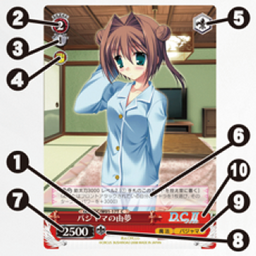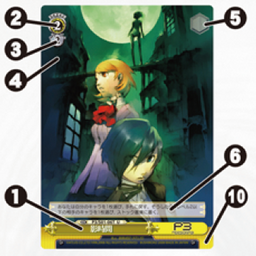Illustration of Card Components
|
Description of Card Components
Name
This is the name of the card. When referenced in the card text on another card it will have 「」 around it.
Type
There are 3 Types of cards in Weiß Schwarz; they are the Character Cards, Event Cards, and Climax Cards.
Character Card
- Character cards are denoted by "CH" above the card name and are your primary means of combat in the game. They are mainly played in the Main Phase of the game.
Event Card
- Event cards are denoted by "EV" above the card name and are cards with varying effect; their play requirement is the same as that of character cards, but are generally fire and forget and do not stay around on the battlefield.
Climax Card
- Climax cards are denoted by "CX" above the card name and are cards with powerful abilities that could change the tide of battle; all climax cards only last the turn they are played, and can only be played during the active player's Climax Phase. They are also the only cards capable of negating soul damage, for this reason, each deck is restricted to a maximum of 8 climax cards.
Number
Cards numbers provide a a great deal of information about the card. They indicate the specific series the card is from, what side the card is (i.e. Weiß or Schwarz), if it is from a Trial Deck, Booster Pack, or Extra Pack, and what the rarity of the card is. For more details, see the Card Number page.
Level
Only Character and Event Cards have levels, and they cannot be played if the player is not same level or higher.
Cost
Only Character and Event Cards have cost, and they cannot be played if the player does not pay the cost.
Counter-Attack Icon
This icon is present on some Character Cards and Event Cards, and it indicates that the card or its Startup Ability may be used during the Counter Step of the Attack Phase of the active player's turn.
Trigger Icon
This icon is present on every card despite some cards being blank. The trigger icon details the type of additional bonus given to an attacking character during the Trigger step of battle. Character cards (at the time of writing) will typically give additional soul damage according to the number of soul triggers printed on the card (ex: If an attacking character that has 1 soul naturally triggers a card that shows 1 soul trigger icon, the attack now hits for 2 soul). Climax cards however have special trigger icons that range from drawing extra cards to sending opponent characters back to their owner's hand. Climax trigger icon types are grouped by color with some colors having exclusive access to some triggers and are detailed in the Color section below.
Card and/or Flavor Text
The Card Text provides additional information on card functions and abilities. Cards with no additional functions or abilities will not have any Card Text. Flavor Text provides additional information about the card that has no effect on the game mechanics. Not all cards will have Flavor Text.
Power
Only Character Cards have this attribute, and it is used to determine the outcome of battles between two characters in the Battle Step of the Attack Phase.
Soul Points
Soul Points is used in the calculation of the amount of damage to the opposing player when the active player attacks.
Characteristic
Each Character Card is given up to 2 characteristic based on its series, although rare, there are also cards with no characteristic, and cards that could gain a third characteristic via its ability. Certain card effects depend on these, and some Deck strategies rely heavily upon cards of same characteristic to function efficiently. For more details see Characteristic.
Color
All cards in Weiß Schwarz belongs to one of the four colors, Yellow, Green, Red and Blue, each of which generally contain cards that specialize in certain areas. The description below only gives a general outline, and only highlight the focus of the color. It does not mean that only Yellow cards have bounce abilities or only Red cards have removal abilities. It is also important when playing cards, as a card cannot be played unless a card of the same color is in the Level Area or the Clock Area (unless it is a Level 0 Character or Event card).
Yellow "Speed"
- Yellow contains many automatic Power pump abilities capable of boosting characters in the player's own turn and are able to perform removal via a variety of bounce effects to temporarily disrupt the opponent's board state. Coupled with powerful Soul pump ability, Yellow decks are designed offensively to defeat opponent quickly (ex: "Koi ni Naritai AQUARIUM" Yoshiko Tsushima"). Although powerful on paper, the high Soul Points when attacking also means that most Yellow decks are susceptible to damage cancel, and are sometimes disadvantaged. By their nature most Yellow decks are strong on the active player's turn and weak on the opponent's turn. Despite this weakness however, there are also many Yellow cards with unique effect such as strong CIP ("when this card comes into play...") effects which can give a myriad of advantages for the turn, power pump, invulnerability to opponent card effects, and even dealing extra damage upon an opponent cancelling initial damage (ex: "Kuroyukihime, Bond of "Accel World"). This is also shown through the Yellow exclusive climax triggers which are commonly referred to as Shot (ex: "Origin Bullet") and Wind (ex: "Means to Remain Existing"). Shot grants players damage insurance by dealing additional damage upon their opponent's cancelling and Wind sends characters back to the opponent's hand. With clever application of Yellow's unique effect and combined with several control mechanism such as sending specific cards to the top of an opponent's deck to increase the chances of a successful attack, Yellow can be a powerful color in the right hands.
Green "Economy"
- Green cards are strong in Power pump, and contains many expensive, but powerful overcosted characters, they also contains a variety of counter cards and Stock generation ability to support the costly playstyle of Green cards (ex: "Honoka, Quiet Literary-Type Girl"). Generally speaking, Green places its focus on getting very powerful cards on field that most decks do not have the resources to play. In return for their heavier costs, low level Green cards can sometimes beat down even a level 3 opponent! This however, also means that in situations where these effects cannot be activated (due to a lack of stock), Green cards are considerably weaker so management is key. Green cards also contain the ability to decrease an opponent's power(which can be used to kill weak backrow characters) as well as lowering opponent soul (ex: "Cat-Eared Mikuru") . On the occasions that Green decks do manage to gain massive resources through their fast stock acquisition cards, powerful effects such as "Clock Shooting" (ex: "Sweets Danshi" Choromatsu") which sends defeated opponents directly to the clock zone instead of the waiting room (albeit at a usually hefty cost), can overwhelm your opponent if set up correctly. To help with stock acquisition, the Green exclusive climax triggers known as Gold Bar (ex: "The Sound You Heard Sometime") and Gold Bag (ex: "Extended Hand") allow players to acquire resources quickly in different ways. Gold Bar allows players to draw the triggered climax instead of sending it to stock, then blind stocking the top card of their deck while Gold Bag allows players to blind stock the top card of their deck after stocking the climax granting 2 stock gained. Due to their resource management based strategies, Green is generally seen as a less consistent color but this varies from set to set as the consistency relies heavily on what cards can utilize the amassed resources rather than a more straightforward play-style such as Yellow.
Red "Recovery"
- The color that contains many cards for burn (dealing damage without attacking), salvage (taking cards from the waiting room to hand) and removal, most of which directly leads to victory. Character wise, Red offers a stable lineup of high powered characters, cards that kill opponents when killed (ex: "Battle Stance" Jean"), characters capable of salvage, characters capable of high power levels, and cards that summon from the waiting room (ex: "Phoena, Live Together And Fight Together"). Due to the ability to salvage, Red is considered a very strong colour when it comes to an attrition battle and allows for many comeback mechanics for defense and extra damage on attack. This is shown very clearly in the Red exclusive climax triggers Door (ex: "Chosen Existence") and Standby (ex: "We Are Poppin'Party"). Upon being triggered, Door has the ability to take characters from the waiting room back to hand while Standby allows players to play characters directly from the waiting room 1 level higher than the triggering player currently is (albeit rested). Due to Red's requirements for players to utilize the waiting room, Red decks require a good amount of foresight and planning to play efficiently (although this varies heavily by set) with their naturally high power being helpful in wasting an opponent's resources to get over your cards with burn to keep damage pressure up due to a lack of card advantage without a set up waiting room.
Blue "Advantage"
- The color that represents defense, many Blue characters have cards that gain abilities on the opponent's turn (ex: "Yusuke & Goemon - FOX") and special encore abilities that increases their survival ability. Blue is also equipped with the ability to heal often. Although in most card games a healing strategy tends not to be the mainstream, in Weiß Schwarz due to the system's nature where 「dealing damage is uncertain due to damage canceling, but healing is certain」, healing strategies, and thus Blue cards are often in an advantageous position. However, Blue shines through its ability to draw many cards at once for generally low costs (ex: "Uniform of Rabbit House" Maya") and always being prepared for their next turn not through power or board control but by always having cards ready to play. By forcing the opponent to use many resources to get over strong defensive cards, Blue is able to control the battle through gaining large amounts of cards in hand to replenish their field, some cards going so far as to allow players to draw a card simply for attacking. This theme of hand advantage is shown through the Blue exclusive climax triggers Book (ex: "Romeo And Cinderella") and Gate (ex: "Smile of an Oni") (occasionally known as Pants due to its visual design). Book allows players to flat out draw cards upon being triggered while Arch allows players to recover any climax card that is in the waiting room (which can set up many powerful climax combos for certain cards). With the Blue strategy of gaining large amounts of cards every turn, Blue is a very powerful color not just for their unique effects but in their ability to thin the deck out in an way that actively benefits the player.
Note: As of recent, colors differentiation has changed dramatically by set and these guidelines are not always accurate representations of color. For example, one of the most powerful burn effects (at the time of writing) is not in Red as would be expected but in Blue! (see: "Zwei Form" Illya"). A recommendation for new players is to look at sets individually and see what each color has to offer by set while keeping these color concepts in mind as less of a law and more as a loose guideline.
Pack
The pack represents the specific series that the card comes from. A list of them can be found in the Weiß or the Schwarz page.

